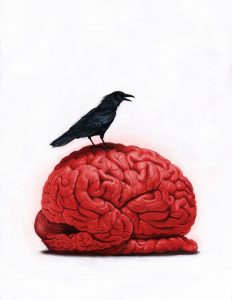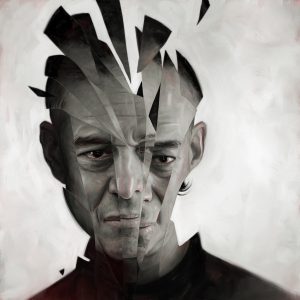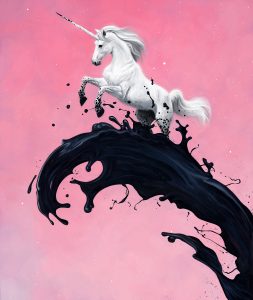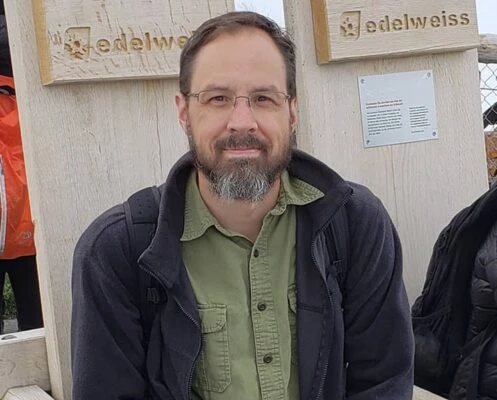
This month’s Apex Magazine cover artist is award-winning illustrator Robert Carter. Combining a strong foundation in portraiture with a unique sense of visual and conceptual ideas, Carter creates striking, vibrant, and textured pieces ranging from the realistic to the surreal.
Apex Magazine: Your cover for this month’s Apex Magazine, “Unraveling Fire II boy,” challenges the viewer to interpret the idea for themselves. Are you ever asked to explain your surreal pieces, and if so how do you usually answer? Do people give you different interpretations that you might not have expected?
Robert Carter: Yes, I’m asked fairly frequently to explain the meaning of various pieces. If it was a commissioned illustration, say for something like the Washington Post “Medical Mysteries” column of which I’ve done several, when not reading the accompanying report it can certainly have the viewer scratching their head. In those cases, I will usually just explain the article and what medical condition the patient had had, etc. What I like about those however is when taken out of context the viewer can apply their own interpretation, which more often than not is much more interesting than its original purpose.
AM: Many of your portrait pieces offer a surreal view of a known person, and others often are more straightforward portraits. Are those personal choices as you work, or do clients ask for something surreal when they commission you for a portrait? How do requests from the commissions affect your frame of mind or even the final piece?
RC: It varies. Sometimes the client knows exactly what they want, be it a straight forward portrait or some other concept. In those cases, I’ll certainly do what they ask but also try and offer up other ideas I feel may work better. If not only better for me as far as the way I work goes, but also a solution that my style will work with. Time is also a factor. If it’s a rush job and I only have one or two days to complete a final piece, a straight up traditional portrait is gonna be the way to go. If the piece is left solely up to me, and I have the time, I like to explore more than the typical head n’ shoulders mug shot. I enjoy adding extra layers of meaning which reflects the personality or history of the subject, or at least add a little something to give it extra interest visually. That being said, sometimes a straight up portrait can be the most beautiful or powerful.
AM: On your DeviantArt bio, you mention returning to school for computer animation, as well as expanding and exploring your work. How does that exploration affect your work over a short term, say with individual projects, versus over the length of your career so far?
RC: I always have in the back of my mind: how can I make this better, what new thing can I try or improve upon, be it the tools I’m using or the way I’m using them, explore new compositions or colour palettes, textures, lighting, or hardware and software etc. With each new project, when I have the opportunity to mix it up, even if it’s a subtle change something only I would notice or know about, I try it. Now and then however I feel I need to do something drastically different but still within the creative arts. Like when I took a year off to try my hand at computer animation. Even though I went back to illustration afterwards, it was a great experience and I’m glad I did it despite the fact it almost killed me ... That course was grueling!
AM: Working on portraits of real-life personalities, especially those in the news currently, do you find your opinion or beliefs about that person change as you work? How do you approach painting someone whose ideologies differ from yours?
RC: In most cases I’m being commissioned by a magazine or paper to paint the portrait of a particular person and the story has its own take on that individual at the time. My job is to not only paint the subject’s portrait but also adhere to the opinion of the author of that person in their article with my illustration. I’ve never been asked to paint someone to whom I have complete disdain for and where the story sheds that someone in a positive light. If I were, I would have to decline. When it comes to politics, I’m not especially politically minded so generally I don’t care much. Although I haven’t been asked to paint Trump yet!
AM: You mention in your bio that you now prefer digital work, for speed and flexibility. Is your approach to digital art creation different from working with a traditional medium? Does flexibility in digital art allow you the freedom to explore, or trap you with too many possibilities?
RC: The way I paint digitally is very similar to the way I work traditionally because I deliberately limit the tools I use. It’s true, you can get lost in the myriad of digital options there are to choose from. But because I started out working in oils and developed my style painting traditionally, when I made the move to digital I wanted to maintain the look I had already developed. It took some time to teach myself not only how to paint digitally but also to imitate the look of my own work. I think I’ve got it down pretty close now.












